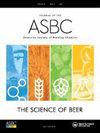Comparative Investigation of Flavors in Red and Brown Flemish Beers: Key-Role of Brettanomyces and Torrefied Malts in Ethylphenols Occurrence
IF 1.8
4区 农林科学
Q4 BIOTECHNOLOGY & APPLIED MICROBIOLOGY
Journal of the American Society of Brewing Chemists
Pub Date : 2022-08-30
DOI:10.1080/03610470.2022.2109380
引用次数: 0
Abstract
Abstract Red and brown Flemish sour beers form a distinct class of Belgian beers obtained by mixed (yeast/lactic bacteria) microbial fermentation and often resulting from blending a 1-to-2-year-old beer with a younger one to obtain a balance between acidic character and sweetness. A detailed composition in volatiles (phenols, lactones, esters, alcohols, acids, …) of three beers representative of the red and brown subcategories is presented. GC data were obtained after different extraction procedures, including solvent-assisted flavor evaporation (SAFE) and headspace. The first results showed the influence of Brettanomyces yeast on the phenol and ester contents. An efficient Brettanomyces activity in the red sour beers (especially in Rodenbach Vintage) was observed, favored by long maturation in wooden casks. This was organoleptically perceived by the horsey flavors brought by 4-ethylguaiacol and 4-ethylphenol, and the solvent-like ethyl acetate through esterase activity. The brown Flemish sour beer (produced in stainless steel fermenters) showed significantly more unreduced 4-vinylguaiacol and 4-vinylphenol, although traces of 4-ethylguaiacol and 4-ethylphenol were also detected (most probably here issued from torrefied malts, as suggested by the opposite substituted phenol/guaiacol ratio).佛兰芒红色和棕色啤酒风味的比较研究:啤酒发酵菌和麦芽发酵菌在乙基酚含量中的关键作用
红色和棕色佛兰德酸啤酒形成了比利时啤酒的一个独特类别,由混合(酵母/乳酸菌)微生物发酵获得,通常是将1至2年的啤酒与较年轻的啤酒混合,以达到酸性和甜味之间的平衡。详细的组成挥发物(酚,内酯,酯,醇,酸,…)的三种啤酒代表的红色和棕色亚类提出。采用溶剂辅助风味蒸发法(SAFE)和顶空法等不同的提取方法,获得了不同的气相色谱数据。第一个实验结果显示了酵母对啤酒中酚和酯含量的影响。在红酸啤酒(特别是在罗登巴赫年份)中观察到有效的布雷顿酸菌活性,在木桶中长时间成熟。这是由4-乙基愈创木酚和4-乙基苯酚以及溶剂状乙酸乙酯通过酯酶活性带来的马味所感知的。棕色佛兰德酸啤酒(在不锈钢发酵罐中生产)显示出更多未还原的4-乙烯基愈创木酚和4-乙烯基酚,尽管也检测到4-乙基愈创木酚和4-乙基酚的痕迹(很可能来自于发酵麦芽,从相反的取代酚/愈创木酚比例可以看出)。
本文章由计算机程序翻译,如有差异,请以英文原文为准。
求助全文
约1分钟内获得全文
求助全文
来源期刊

Journal of the American Society of Brewing Chemists
工程技术-生物工程与应用微生物
CiteScore
4.00
自引率
20.00%
发文量
41
审稿时长
3 months
期刊介绍:
The Journal of the American Society of Brewing Chemists publishes scientific papers, review articles, and technical reports pertaining to the chemistry, microbiology, and technology of brewing and distilling, as well as the analytical techniques used in the malting, brewing, and distilling industries.
 求助内容:
求助内容: 应助结果提醒方式:
应助结果提醒方式:


